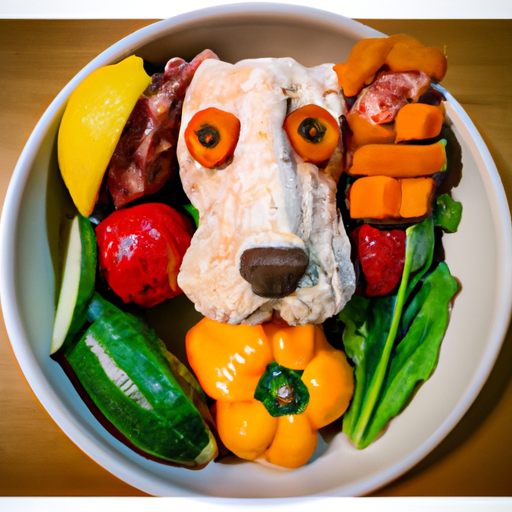As a dog owner, it’s your responsibility to ensure your canine companion receives the best possible care. This, of course, includes providing a healthy, balanced diet. In recent years, one particular feeding method has gained considerable attention – raw diets for dogs.
Table of Contents
- What is a Raw Diet for Dogs?
- Types of Raw Diets
- Pros and Cons of Raw Diets
- How to Transition Your Dog to a Raw Diet
- FAQs
Key Takeaways
- Raw diets for dogs involve feeding primarily uncooked ingredients, including meats, bones, fruits, and vegetables.
- There are several types of raw diets, each with its own benefits and drawbacks.
- Transitioning your dog to a raw diet should be done gradually and under the guidance of a veterinarian.
What is a Raw Diet for Dogs?
A raw diet for dogs, also known as a BARF diet (Biologically Appropriate Raw Food or Bones and Raw Food), involves feeding your pet primarily uncooked ingredients. These can include raw meats, bones, fruits, vegetables, and occasionally dairy and grains. The idea behind this feeding method is to mimic the diet of a dog’s wild ancestors and provide nutrition that is closer to what they would naturally consume.
A raw diet can be homemade or purchased pre-made from a pet store. Many dog owners find value in the raw diet’s focus on natural, unprocessed ingredients, which contrast with the often heavily-processed components of commercial dog foods (source).
Types of Raw Diets
There are several types of raw diets, each with its own specific recipes and guidelines. The most common include:
- Homemade raw diet: This involves preparing meals from scratch using fresh, raw ingredients. This method requires careful planning and knowledge of canine nutrition, as balancing the necessary nutrients can be complex.
- Commercial raw diet: These are pre-packaged, raw meals sold in pet stores or online. They come in various forms, including frozen, freeze-dried, and dehydrated. These diets are typically formulated to meet nutritional standards and offer more convenience than homemade diets.
- Prey model raw diet: This diet aims to mimic the diet of a wild canine, focusing primarily on animal products. It typically includes 80% meat, 10% bone, and 10% organs and avoids fruits, vegetables, and grains.
Before choosing a raw diet for your dog, it’s essential to consult with a veterinarian to ensure it will meet your pet’s nutritional needs.
Pros and Cons of Raw Diets
Like any feeding method, raw diets come with pros and cons.
Pros
* Natural Ingredients: Raw diets focus on fresh, natural ingredients, which can be healthier than processed alternatives.
* Dental Health: Chewing on raw bones can help clean your dog’s teeth and promote dental health.
* Improved Coat Health: Many dog owners report an improvement in their dog’s coat health after transitioning to a raw diet.
Cons
* Nutritional Imbalances: Without careful planning, raw diets can lead to nutritional deficiencies or excesses.
* Cost: Raw diets, particularly commercial ones, can be more expensive than traditional dog food.
* Safety Risks: Raw diets carry the risk of bacterial contamination, which can pose health risks to both dogs and their owners.
If you’re considering a raw diet for your dog, it’s worth looking into One Top Dog’s guide on choosing the right dog food, which includes tips on evaluating your dog’s nutritional needs.
How to Transition Your Dog to a Raw Diet
Switching your dog to a raw diet should be a gradual process. Start by replacing a small portion of your dog’s regular food with raw food, gradually increasing the raw portion over several weeks. This will help your dog adjust to the new diet and reduce the risk of digestive upset.
Also, it’s crucial to monitor your dog’s health closely during the transition period. If you notice any adverse effects, such as vomiting, diarrhea, or changes in behavior, contact your veterinarian immediately. For more information on transitioning your dog to a new diet, check out One Top Dog’s guide on food transitions.
FAQs
Q: Are raw diets safe for all dogs?
A: Not all dogs are suitable candidates for a raw diet. Puppies, senior dogs, pregnant dogs, and those with certain health conditions may require specially-formulated diets. Always consult with a veterinarian before making significant changes to your dog’s diet.
Q: Can I feed my dog raw meat from the grocery store?
A: While it’s technically possible, it’s crucial to ensure the meat is fresh and stored properly to minimize the risk of bacterial contamination.
Q: Do raw diets provide all the necessary nutrients for dogs?
A: A well-planned raw diet can meet a dog’s nutritional needs. However, it requires a thorough understanding of canine nutrition and careful meal planning. For a balanced diet, consider consulting with a veterinary nutritionist or using a commercially-prepared raw diet.
In conclusion, a raw diet for dogs can offer a range of benefits, from improved dental health to a shinier coat. However, it’s not without its challenges and potential risks. If you’re considering this feeding method for your pet, do your research, consult with a veterinarian, and always prioritize your dog’s health and wellbeing. For more information on dog nutrition and care, visit One Top Dog’s blog.



